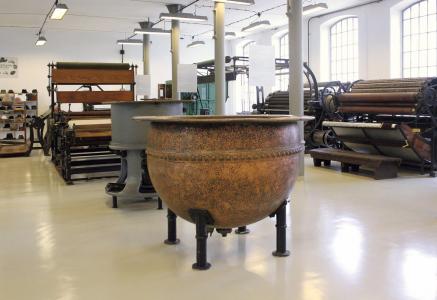Carding willow, self-actor mule, shearing machine...
Textile Technology Artefacts
The Old Factory boasts a unique collection of machines and equipment once used in the textile factories in Bielsko-Biała. Most of these were employed in the production of coarse woollen fabrics, which included the well-known Bielsko dresses. Some of the machines were built many years ago in the local factories, whilst others were transported to ‘Silesian Manchester’ from such countries as Czechoslovakia, Germany, Great Britain and the USSR. The four display halls correspond to particular sections of a former factory. In the spinning section, wool was spun into yarn. Two machines dominate this room: a triple-component carding machine (1895) and a self-actor mule (1890) from G. Josephy’s machine factory in Bielsko; there is also a carding willow to loosen and mix the raw material (from the ‘Befama’ factory, 1958). In the preparatory treatment section, the yarn was prepared for weaving, forming warp and weft in the winding, warping, weft winding and twisting machines. There is the master craftsman’s office in a separate room with glazed window, overlooking the preparatory treatment section. The master craftsman’s job was to supervise the workers. Next to this office is a small laboratory where wool, yarn and finished products were inspected. The weaving section contains a large selection of looms: from the simplest hand looms, through Jacquard to power looms. On display here, for example, is an English power loom for cotton textiles manufactured by G. Hattersley (1906), a ‘Schwabe’ power buckskin loom from Bielsko (1930s) and post-war shuttle-less looms from the USSR and Czechoslovakia. Textiles underwent final processing in the finishing section, which involved fulling in a cylinder fulling mill, producing a napped surface on the teaselling machines, and finally making the fabric surface even on the shearing machines. Part of the display hall has been given over to a number of machines used for the production of hats. These include cone carding, eccentric felting and two fulling machines, a head extruding press, a brim drawing frame and a drawing frame for broader brims, collected from various 20th century European manufacturing plants.













